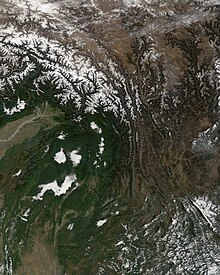
Back Сіна-Тыбецкія горы Byelorussian Сино-Тибетски планини Bulgarian འཕྲེད་བཅད་རི་རྒྱུད Tibetan Hengduan Shan Catalan Hengduan Shan (kabukiran) CEB Cheng-tuan-šan Czech Hengduan Shan German Montoj Hengduan Esperanto Montañas Hengduan Spanish Monts Hengduan French
| Hengduan Mountains | |
|---|---|
 Mount Gongga, the tallest summit in the Hengduan Mountains | |
| Highest point | |
| Peak | Mount Gongga |
| Elevation | 7,556 m (24,790 ft) |
| Geography | |
| Countries | China and Burma |
| Range coordinates | 27°30′N 99°00′E / 27.5°N 99°E |




The Hengduan Mountains (simplified Chinese: 横断山脉; traditional Chinese: 橫斷山脈; pinyin: Héngduàn Shānmài) are a group of mountain ranges in southwest China that connect the southeast portions of the Tibetan Plateau with the Yunnan–Guizhou Plateau. The Hengduan Mountains are primarily large north-south mountain ranges that effectively separate lowlands in northern Myanmar from the lowlands of the Sichuan Basin. These ranges are characterized by significant vertical relief originating from the Indian subcontinent's collision with the Eurasian Plate, and further carved out by the major rivers draining the eastern Tibetan Plateau. These rivers, the Yangtze, Mekong, and Salween, are recognized today as the Three Parallel Rivers UNESCO World Heritage Site.
The Hengduan Mountains cover much of western present-day Sichuan province as well as the northwestern portions of Yunnan, the easternmost section of the Tibet Autonomous Region, and touching upon parts of southern Qinghai. Additionally, some parts of eastern Kachin State in neighbouring Myanmar are considered part of the Hengduan group. The Hengduan Mountains are approximately 900 kilometres (560 mi) long, stretching from 33°N to 25°N. Depending on extent of the definition, the Hengduan Mountains are also approximately 400 kilometres (250 mi) wide under the narrowest definition, ranging from 98°E to 102°E. The area covered by these ranges roughly corresponds with the Tibetan region known as Kham.
The Hengduan Mountains subalpine conifer forests is a palaearctic ecoregion in the Temperate coniferous forests biome that covers portions of the mountains.
© MMXXIII Rich X Search. We shall prevail. All rights reserved. Rich X Search